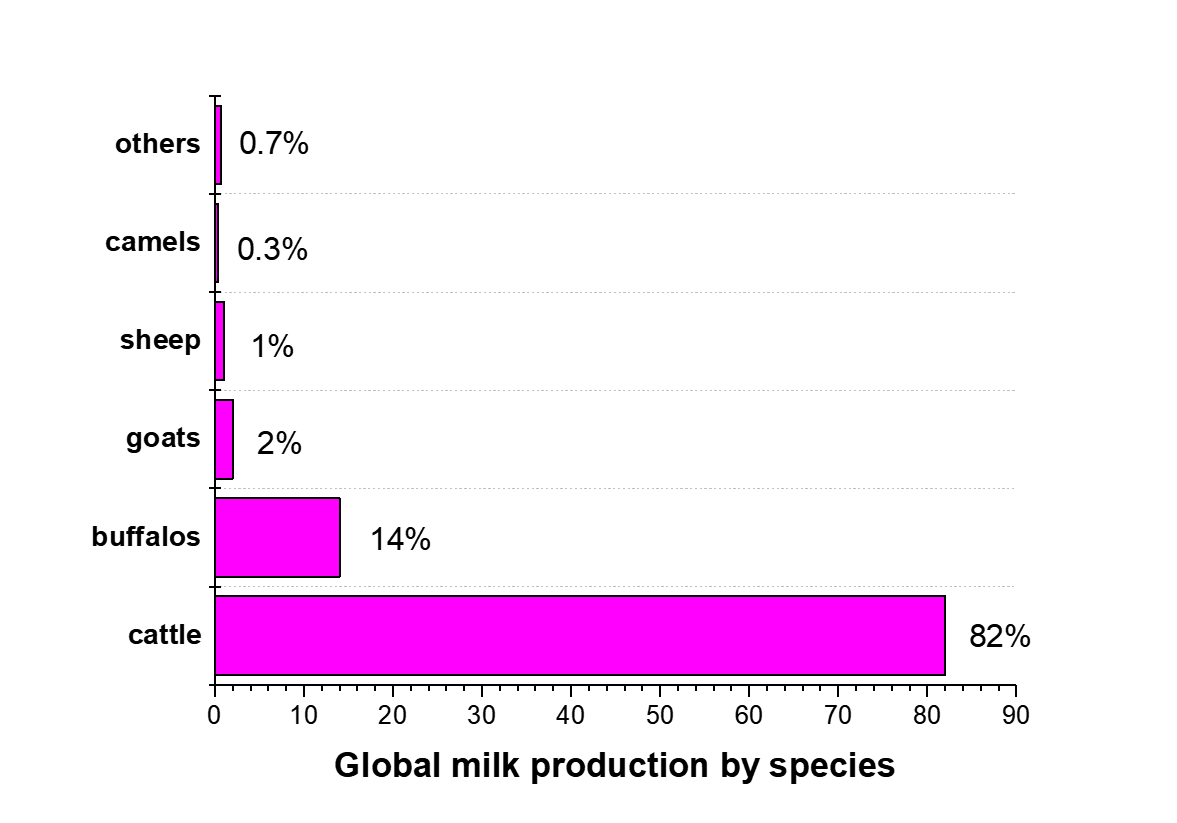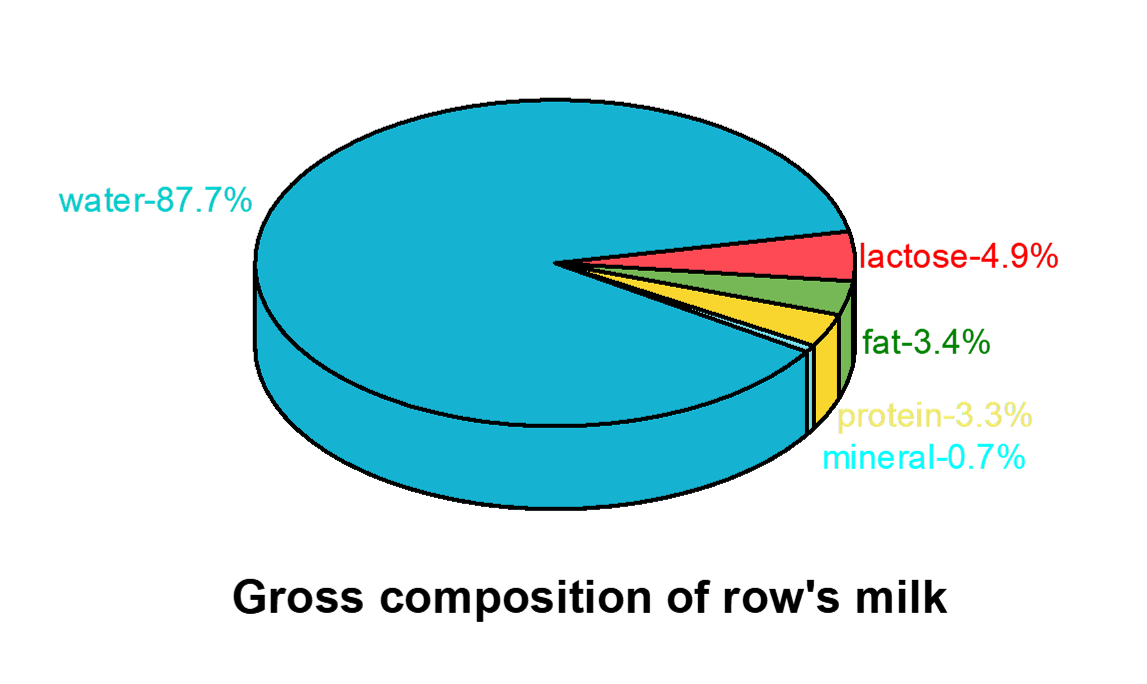82 percent of world milk production is produced by cattle, the rest is filled out by other mammal, such as buffaloes, goats, sheep and camels. As we described in previous article, the milk sold in the market can be classified as eight types. By volume, liquid milk is the most consumed dairy product throughout the developing world. Various countries have different diet habit for milk products. According to the investigation of FAO, more than 6 billion people worldwide consume milk and milk products, of course, the majority of these people live in developing countries. The per capita milk consumption is high for those countries: Argentina, Armenia, Australia, Costa Rica, Europe, Israel, Kyrgyzstan, North America and Pakistan, the consumption is low when inspect Viet Nam, Senegal, Central Africa and East and Southeast Asia.

Now, we will discuss the nutritional components in milk, they are carbohydrate, fat, protein, vitamins, minerals and enzymes.
Carbohydrate
Milk is approximately 4.9% carbohydrate in the form of lactose. Carbohydrates are the primary source of energy for activity. Glucose is the only form of energy that can be used by the brain. Excess glucose is stored in the form of glycogen in the muscles and liver for later use. Carbohydrates are important in hormonal regulation in the body. Lack of adequate levels of glucose in the blood and carbohydrate stores leads to muscle fatigue and lack of concentration. Lactose is a disaccharide made up of glucose and galactose bonded together. Before it can be used by the body, the bond must be broken by the enzyme lactase in the small intestine. People that have decreased activity of lactase in the small intestine may have problems digesting lactose and this is referred to as lactose intolerance or malabsorption.

Fat
Milk is approximately 3.4% fat. Fats are a structural component of cell membranes and hormones. Fats are a concentrated energy source and are the main energy source used by the body during low intensity activities and prolonged exercise over 90 minutes. Fat is the main storage form of excess energy in the body. Fats cushion organs during movement.
The fatty acids in milk fat are approximately 65% saturated, 29% monounsaturated, and 6% polyunsaturated. The polyunsaturated fatty acids in milk fat include small amounts of the essential fatty acids linoleic and linolenic, and approximately 5% trans fatty acids. An important trans fatty acid in milk fat is conjugated linoleic acid (CLA). There are several types (isomers) of CLA in milk that have been shown to inhibit cancer and help maintain lean body mass while promoting the loss of body fat.
Cholesterol is an important component of cell membranes and as a starting material for the production of bile salts and steroid hormones. The body manufactures cholesterol to ensure that an adequate level of cholesterol is available for body functions. High levels of blood cholesterol are associated with increased risk for heart disease.
Protein
Milk is approximately 3.3% protein and contains all of the essential amino acids. Proteins are the fundamental building blocks of muscles, skin, hair, and cellular components. Proteins are needed to help muscles contract and relax, and help repair damaged tissues. They play a critical role in many body functions as enzymes, hormones, and antibodies. Proteins may also be used as an energy source by the body. Nine amino acids must be obtained from the diet and are referred to as the “essential” amino acids: leucine, isoleucine, valine, phenylalanine, tryptophan, histidine, threonine, methionine, and lysine. Proteins that contain all 9 essential amino acids are often called “complete” proteins. Proteins of animal origin and soy are complete proteins, whereas proteins from grains and legumes are missing 1 or more of the essential amino acids, which means that consumers must eat complementary foods in order to get all of the essential amino acids.
Milk protein consists of approximately 82% casein and 18% whey (serum) proteins. Both casein and whey proteins are present in milk, yogurt, and ice cream. In most cheeses the casein is coagulated to form the curd, and the whey proteins contain immunoglobulins which are important in the immune responses of the body. Whey proteins contain branched chain amino acids and have been proposed to have some benefits to athletes for muscle recovery and for preventing mental fatigue.
Vitamins
Vitamins have many roles in the body including metabolism co-factors, oxygen transport and antioxidants. They help the body use carbohydrates, protein, and fat. Vitamin A is a fat soluble vitamin involved in vision, gene expression, reproduction, and immune response.
|
Vitamins |
Functions |
|
Thiamin (vitamin B1) |
a water soluble vitamin that is an enzyme cofactor involved in the metabolism of carbohydrates and branched chain amino acids |
|
Riboflavin (vitamin B2) |
a water soluble vitamin that is an enzyme cofactor involved in electron transport reactions |
|
Niacin (vitamin B3) |
a water soluble vitamin that is an enzyme cofactor involved in electron transport reactions required for energy metabolism |
|
Pantothenic acid (vitamin B5) |
a water soluble vitamin that is an enzyme cofactor in fatty acid metabolism |
|
Pyridoxine (vitamin B6) |
a water soluble vitamin involved in the metabolism of proteins and glycogen (energy stored in the liver and muscles), and in the metabolism of sphingolipids in the nervous system |
|
Folate(Vitamin B9) |
a water soluble enzyme cofactor important in the metabolism of proteins and nucleic acids and blood functions |
|
Cobalamin (vitamin B12) |
a water soluble vitamin involved in protein metabolism and blood functions |
|
Vitamin C |
a water soluble vitamin that is an important antioxidant. It has a role in collagen formation in connective tissue and helps in iron absorption and healing of wounds and injuries |
|
Vitamin D |
a fat soluble vitamin that is important in maintaining blood calcium and phosphorus balance and assists calcium metabolism |
|
Vitamin E |
a fat soluble vitamin that has antioxidant activity |
|
Vitamin K |
a fat soluble vitamin involved in blood clotting, bone metabolism, and protein synthesis |
Minerals
Minerals have many roles in the body including enzyme functions, bone formation, water balance maintenance, and oxygen transport. They help the body use carbohydrates, protein and fat.
|
Minerals |
Functions |
|
Calcium |
plays an essential role in bone formation and metabolism, muscle contraction, nerve transmission and blood clotting |
|
Copper |
a component of enzymes used in iron metabolism |
|
Iron |
a component of blood and many enzymes. It is involved in blood metabolism and oxygen transport |
|
Magnesium |
involved in bone formation, and in enzymes involved in amino acid, cholesterol, and carbohydrate metabolism |
|
Phosphorus |
involved in maintaining body PH, in storage and transfer of energy, and in nucleotide synthesis |
|
Potassium |
an electrolyte that is important in the maintenance of water balance, blood volume and blood pressure |
|
Selenium |
important in oxidative stress response, electron transport, and regulation of thyroid hormone |
|
Sodium |
an electrolyte that is important in the maintenance of water balance and blood volume |
|
Zinc |
a component of many enzymes and proteins, and is involved in gene regulation |
Enzymes
Milk enzymes come from several sources: the native milk, airborne bacterial contamination, bacteria that are added intentionally for fermentation, or in somatic cells present in milk.
|
Enzymes |
Function |
|
Lactoferrin |
an iron binding protein that plays a role in iron absorption and immune response |
|
Lactoperoxidase |
an enzyme that, in the presence of hydrogen peroxide and thiocyanate, has antibacterial properties |
|
Lipases |
a group of enzymes that break down fats, are present in milk but are inactivated by pasteurization, which increases the shelf life of milk |
|
Lactase |
the enzyme responsible for the breakdown of lactose into glucose and galactose for digestion (there is no lactase present in fresh milk) |



